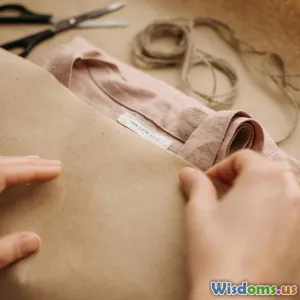
What Happens When You Quit Fast Fashion for Good
9 min read Exploring the profound personal and environmental transformation when quitting fast fashion permanently. (0 Reviews)
What Happens When You Quit Fast Fashion for Good
Fast fashion has become synonymous with cheap, trendy clothes designed for quick consumption and disposal. But lately, many are questioning the true cost behind the glossy racks of affordable styles. What really happens when you quit fast fashion for good? This article explores the profound environmental, financial, and emotional transformations that come with leaving behind the urge for fast, cheap garments — and opting for sustainable, mindful consumption instead.
Understanding Fast Fashion: More than Just Cheap Clothes
Fast fashion brands like Zara, H&M, and Forever 21 have revolutionized the apparel industry by providing quickly produced, low-cost items that mimic the latest runway trends. According to the Ellen MacArthur Foundation, the global apparel production has doubled in the past 15 years, escalating textile waste to alarming levels. Most fast fashion items are worn only a few times before being discarded or donated, contributing to nearly 92 million tons of textile waste annually worldwide, per UNEP reports.
But the environmental toll is just one part of the story. Fast fashion often relies on exploitative labor practices, using cheap worker wages and hazardous conditions in developing countries to keep prices low. Many consumers are also trapped in a cycle, often called “shop-and-throw,” fueling unsustainable lifestyles.
The Environmental Wake-Up Call
One of the most immediate and profound impacts of quitting fast fashion is the reduction of your personal carbon footprint. The fashion industry is responsible for about 10% of global carbon emissions, which is more than the combined impact of international flights and maritime shipping, according to a 2018 study by McKinsey & Company.
When you choose to no longer buy fast fashion, you stop directly supporting massive resource depletion and pollution — including water consumption, chemical pollution, and microplastic waste. For example, producing one kilogram of cotton uses approximately 20,000 liters of water, enough for a single T-shirt. Stopping frequent, low-quality purchases means fewer synthetic garments that shed microfibers into oceans during washing, harming marine life.
A Cleaner Planet Starts With Consumer Choices
Consumer behavior matters. A 2020 survey by GlobalWebIndex suggested that nearly 56% of consumers aspire to buy more sustainable products but are uncertain how to start. Quitting fast fashion sends a strong signal to brands: customers want quality, longevity, and ethics over quantity. This shift pressures retailers to adopt sustainable production methods, such as recyclable materials or zero-waste designs.
Financial Savings and Shifts
At first glance, fast fashion seems incredibly affordable — but what about the hidden and long-term costs? Quitting fast fashion can seem expensive upfront because sustainable pieces often carry a premium price. However, the durability and timeless appeal of such clothing ultimately save money.
Investing in Quality Over Quantity
Instead of buying multiple trendy tops for $10 each that lose shape or wear out quickly, investing $50-$100 in a well-made shirt that lasts years can be more economical in the long run. Behavioral economics expert Dr. Elizabeth Dunn emphasizes that "consuming less but better quality leads to longer satisfaction." This naturally curbs impulse buying and clutter accumulation, encouraging mindfulness.
Moreover, many who quit fast fashion find joy in revitalizing existing wardrobe pieces through mending, tailoring, or swapping within communities—practices that reduce new purchases and promote creativity simultaneously.
Psychological and Social Benefits
Many people discover unexpected emotional advantages in abandoning fast fashion.
Building a Conscious Relationship with Clothes
When you say no to fast fashion, your wardrobe becomes intentional rather than reactive. Psychologist Dr. Jennifer Baumgartner notes that decluttering unsatisfying possessions, including clothes, can reduce stress and enhance well-being. The process cultivates awareness about consumption habits and fosters gratitude for what you own.
Joining a Community of Changemakers
A growing movement of slow fashion advocates, thrift shoppers, and sustainable brands creates a supportive network focused on change. Events like Fashion Revolution Week or local swap meets connect individuals dedicated to ethical choices, amplifying personal impact.
Challenges and How to Overcome Them
While quitting fast fashion is noble, challenges abound:
- Cost barrier: Start by gradually replacing items; thrift shops offer affordable sustainable options.
- Style anxiety: Embrace personal style over trends; capsule wardrobes simplify choices.
- Accessibility: Support brands that transparently disclose their practices and source domestically when possible.
Education plays a crucial role in overcoming these barriers. Websites such as Good On You and tools like the Ethical Fashion Guide help consumers identify responsible brands.
Real-World Examples: Transformative Stories
Jane’s Journey to Sustainability
Jane, a graphic designer from London, noted she used to purchase at least one new garment weekly. After researching fast fashion's impact, she committed to 100% sustainable and second-hand for a year. She saved over $1,000, donated fewer clothes, and cultivated a wardrobe she truly loves.
Patagonia’s Environmental Activism
Patagonia exemplifies an ethical brand encouraging customers to buy less with its "Worn Wear" program. It focuses on durability, repair, and resale to extend a garment's lifecycle, substantially reducing environmental impact.
Conclusion: The Ripple Effect of Quitting Fast Fashion
What happens when you quit fast fashion is transformative not only for the planet but also your wallet, mindset, and community. The decision curtails harmful environmental practices, promotes economic mindfulness, and encourages deeper satisfaction through conscious consumption. It is a powerful step toward redefining our relationship with clothes—from disposability toward longevity and respect.
As Greta Thunberg’s words resonate, "You are never too small to make a difference." Quitting fast fashion might feel daunting but remember, each thoughtful purchase echoes far beyond an individual closet into movements that shape the future of fashion and the earth.
References:
- Ellen MacArthur Foundation (2017). A New Textiles Economy: Redesigning Fashion’s Future.
- United Nations Environment Programme (UNEP) (2019). Putting the brakes on fast fashion.
- McKinsey & Company (2018). Fashion’s environmental impact.
- GlobalWebIndex (2020). Consumer attitudes toward sustainability.
- Baumgartner, J. (2020). The Psychology of Decluttering.
- Patagonia Worn Wear Program: https://wornwear.patagonia.com
By quitting fast fashion for good, you become an agent of change — for yourself and our shared planet.
Rate the Post
User Reviews
Popular Posts


















